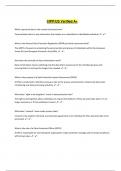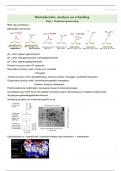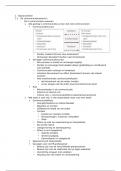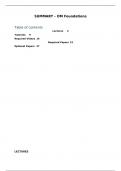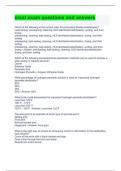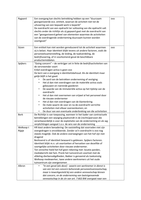Name and briefly describe any 5 purposes of assessment (10)
(see p. 6-7 of textbook)
1. The purpose of assessment is to provide reliable, valid and fair measurements of the
achievements of a learner in a specific subject.
2. We assess to guide and motivate learners by giving positive reinforcement, and creating a
stimulating environment that encourages learners to learn while guiding their progress.
3. We assess to promote learners, and provide them with certificates which they can use to
advance to the next level or gain employment
4. We assess to find out whether instruction was effective
5. We assess to help identify/rectify barriers to learning
Different types of assessment are used for different purposes. Complete the table on types of
assessment (10)
See p. 17 and 65
Type of assessment When does it take place? What is its purpose?
Formative assessment During the learning process Determines the progress of
learners towards achieving the
outcomes, and the
appropriateness of learning
acquired
Summative assessment At the end of a learning cycle, Determines the overall
programme or phase achievement of learners
Diagnostic assessment At any time during the learning Determines the nature and
process cause of barriers to learning
experiences by specific
learners
Baseline assessment Before learning commences Determines what learners
know and can do
Systematic assessment In the exit Grades i.e. grades 3, Evaluates the appropriateness
6 and 9 of the education system
Bloom’s taxonomy provides a useful structure in which to categorise questions when assessing
learning. Identify a topic in your chosen subject and develop test questions reflecting the six levels
of learning according to Bloom. Provide two examples of questions for each of the 6 levels. All
questions should be related to the chosen topic.
(See p.80-81 of textbook and p.50 of CAPS document)
Subject: English home language
Grade: 4
Topic: Water in South Africa
, Category Questions
Knowledge 1. List the 3 forms of water
2. Give a definition of what water pollution is
Comprehension 1. Give examples of two (2) ways in which you use water
every day.
2. Explain why people need water
Application 1. Draw a simple diagram of a water cycle. Use at least 5
labels for your diagram.
2. Why do we need to look after our water resources?
Analysis 1. Look at the pie chart of different users of water, and
organise them from the biggest user of water to the
smallest user of water.
2. Differentiate between the different ways each user uses
their water.
Synthesis 1. Design a plan of all the ways you can save water at home
2. What will happen to South Africa if it does not rain for a
year
Evaluation 1. Conduct a debate about the effects of water pollution on
the environment.
2. Write a letter to the department of water and sanitation,
advising on what can be done to reduce water wastage in
your area.
Explain five benefits and 5 limitations of high-stake assessments (such as a final exam that count a
high percentage of the total marks) (10)
(See p.22 of textbook)
Benefits
• They assure that standards are taken seriously, motivate teaching of the standards and hold
institutions accountable for learner performance
• They motivate learners to learn and increase the emphasis on learner achievement
• The provide the same (high) expectations and the same basis of evaluation for all learners
• They provide information that can inform policy makers on the quality of education
• They make it possible to monitor efforts by the institution to improve
• They identify learner strengths and weaknesses to target instruction
• They allow for recognition of institutions and teachers of learners who perform well or
significantly improve their performance
Limitations
• What you test (and how you test it) is what you get; you cannot uncover what is not tested.
• It places too much emphasis on a single test score, which may not reflect true changes in
learner achievement
• Nationwide assessment leads to a narrow nationwide curriculum
• The tests are unfair to low socio-economic learners and schools
• High-stakes assessment results in too much time spent on preparing learners to take the test
• It does not provide information that can improve instruction
,List and briefly explain the stages involved in the assessment cycle (10)
(See p.28-29 of tutorial letter 501 and CAPS documents under the Assessment section.)
Assessment is a continuous, planned process of identifying, gathering and interpreting information
regarding the performance of learners, using various forms of assessment. It involves planning and
preparing for assessment (as suggested in the definition) and the following four steps:
• generating and collecting evidence of achievement
• evaluating this evidence
• recording the findings
• using this information to understand and thereby assist the learner’s development in order
to improve the process of learning and teaching.
Assessment should be both informal and formal. In both cases regular feedback should be provided
to learners to enhance the learning experience.
What is the role of moderation according to CAPS? (10)
• Moderation refers to the process that ensures that the assessment tasks are fair, valid,
manageable and reliable (i.e. credible).
• Comprehensive and appropriate moderation practices must be in place for the quality
assurance of all subject assessments.
• The role of moderation is to check the assessment document against the school policy
regarding the technical layout
• It should also suggest improvements to the assessment document.
Teachers may achieve assessment for learning in several ways. List and briefly explain 5 things
teachers can do to achieve assessment for learning (10)
(See p.12-13 of textbook)
• Clarify and share intentions and criteria. Learners must know, in advance, what is expected
of them (their achievement targets) and understand the purpose of the learning
programme.
• Facilitate effective classroom discussion. Teachers must also actively involve learners in
communicating with the teacher and their families about their achievement status and
improvement.
• Give feedback that moves the learner forward. Classroom assessment must be translated
into descriptive feedback rather than judgmental feedback. Learners must know how they
can improve.
• Activate learners as instructional resources for one another. Groups assessment and peer
assessment assist learners to learn from each other.
• Use evidence of learning to adapt/improve instruction. Assessment results can be used to
adjust instruction.
, Indicate the steps teachers have to follow in assessing their learners as prescribed in CAPS and
describe each step in no more than two sentences. (10)
(I don’t see it in my CAPS documents – I got these from the group)
• Step 1: Plan the assessment properly and the assessment strategies must be taken into
consideration. Several assessment strategies must be used and it must be clear how
assessment will be done and how it will contribute to learning throughout the lesson.
• Step 2: Ensure that the learners know exactly what is required, i.e. every assessment must
be described in detail. The learners must know what is expected of them in terms of
knowledge, skills and attitudes (competencies).
• Step 3: Develop an assessment instrument (e.g. memorandum, criteria for assessment,
rubric, etc.). The instrument should indicate marks allocated to answers and length of
answers.
• Step 4: Let the assessment be moderated by a mentor and any improvements must be
considered.
• Step 5: Prepare the learners for the assessment task by specifying the content that must be
learnt. It must indicate the competencies that will be assessed: knowledge, skills and
attitudes.
What should teachers choose in assessing learner’s work?
• The teaching method
• The assessment method
• Material to be used
• Activity to provide practice
Indicate the differences between assessment OF learning and assessment FOR learning (10)
Assessment OF learning (see p.12-13 of Assessment FOR learning (see p.23 of textbook)
textbook)
It is seen as Summative assessment – It It is seen as Formative assessment – it
determines the overall achievement and determines the progress of the learners
learning success of learners.
It occurs at the end of a learning event, period, Occurs continuously during the learning
cycle, or phase process
Evaluates what the learners know (i.e. Assessment is used to advance student learning
determines the learning that has taken place (i.e. to improve and inform learning)
The assessment results are tested against a set The assessment results are tested against the
of criteria that sets out the minimum standard learner’s own accomplishments to see whether
required to continue to the next phase or they have improved or not.
grade.
Feedback is usually provided in the form of Feedback is usually detailed, descriptive and
marks, scored or grades shows learners where and how they can
improve their learning. It tells learners where
they are in terms of their learning, as well as
how to get from where they are to where they
need to be

